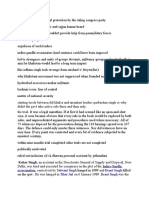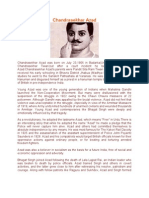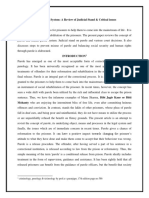Killing of John Saunders
Killing of John Saunders
Uploaded by
Bineet KumarCopyright:
Available Formats
Killing of John Saunders
Killing of John Saunders
Uploaded by
Bineet KumarOriginal Description:
Copyright
Available Formats
Share this document
Did you find this document useful?
Is this content inappropriate?
Copyright:
Available Formats
Killing of John Saunders
Killing of John Saunders
Uploaded by
Bineet KumarCopyright:
Available Formats
Revolutionary activities
Killing of John Saunders
In 1928, the British government set up the Simon Commission to report on the political situation in India. Some Indian
political parties boycotted the Commission because there were no Indians in its membership, [c] and there were
protests across the country. When the Commission visited Lahore on 30 October 1928, Lala Lajpat Rai led a march
in protest against it. Police attempts to disperse the large crowd resulted in violence. The superintendent of police,
James A. Scott, ordered the police to lathi charge (use batons against) the protesters and personally assaulted Rai,
who was injured. Rai died of a heart attack on 17 November 1928. Doctors thought that his death might have been
hastened by the injuries he had received. When the matter was raised in the Parliament of the United Kingdom, the
British Government denied any role in Rai's death.[31][32][33]
Singh was a prominent member of the Hindustan Republican Association (HRA) and was probably responsible, in
large part, for its change of name to Hindustan Socialist Republican Association (HSRA) in 1928.[34] The HSRA
vowed to avenge Rai's death.[24] Singh conspired with revolutionaries like Shivaram Rajguru, Sukhdev Thapar,
and Chandrashekhar Azad to kill Scott.[27] However, in a case of mistaken identity, the plotters shot John P.
Saunders, an Assistant Superintendent of Police, as he was leaving the District Police Headquarters in Lahore on 17
December 1928.[35]
HSRA pamphlet after Saunders' murder, signed by Balraj, a pseudonym of Chandrashekhar Azad
Contemporary reaction to the killing differs substantially from the adulation that later surfaced. The Naujawan Bharat
Sabha, which had organised the Lahore protest march along with the HSRA, found that attendance at its subsequent
public meetings dropped sharply. Politicians, activists, and newspapers, including The People, which Rai had
founded in 1925, stressed that non-co-operation was preferable to violence. [30] The murder was condemned as a
retrograde action by Mahatma Gandhi, the Congress leader, but Jawaharlal Nehru later wrote that:
Bhagat Singh did not become popular because of his act of terrorism but because he seemed to
vindicate, for the moment, the honour of Lala Lajpat Rai, and through him of the nation. He
became a symbol, the act was forgotten, the symbol remained, and within a few months each
town and village of the Punjab, and to a lesser extent in the rest of northern India, resounded
with his name. Innumerable songs grew about him and the popularity that the man achieved was
something amazing.[36]
Killing of Channan Singh
After killing Saunders, the group escaped through the D.A.V. College entrance, across the road from the District
Police Headquarters. Chanan Singh, a Head Constable who was chasing them, was shot dead by Chandrashekhar
Azad.[37] They then fled on bicycles to pre-arranged safe houses. The police launched a massive search operation to
catch them, blocking all entrances and exits to and from the city; the CID kept a watch on all young men leaving
Lahore. The fugitives hid for the next two days. On 19 December 1928, Sukhdev called on Durgawati Devi,
sometimes known as Durga Bhabhi, wife of another HSRA member, Bhagwati Charan Vohra, for help, which she
agreed to provide. They decided to catch the train departing from Lahore to Bathinda en route to Howrah (Calcutta)
early the next morning.[38]
Escape from Lahore
Bhagat Singh and Rajguru, both carrying loaded revolvers, left the house early the next day. [38] Dressed in western
attire (Bhagat Singh cut his hair, shaved his beard and wore a hat over cropped hair), and carrying Devi's sleeping
child, Singh and Devi passed as a young couple, while Rajguru carried their luggage as their servant. At the station,
Singh managed to conceal his identity while buying tickets, and the three boarded the train heading to Cawnpore
(now Kanpur). There they boarded a train for Lucknow since the CID at Howrah railway station usually scrutinised
passengers on the direct train from Lahore. [38] At Lucknow, Rajguru left separately for Benares while Singh, Devi and
the infant went to Howrah, with all except Singh returning to Lahore a few days later. [39][38]
Delhi Assembly bombing and arrest
For some time, Bhagat Singh had been exploiting the power of drama as a means to inspire the revolt against the
British, purchasing a magic lantern to show slides that enlivened his talks about revolutionaries such as Ram Prasad
Bismil who had died as a result of the Kakori conspiracy. In 1929, he proposed a dramatic act to the HSRA intended
to gain massive publicity for their aims.[26] Influenced by Auguste Vaillant, a French anarchist who had bombed
the Chamber of Deputies in Paris,[40] Singh's plan was to explode a bomb inside the Central Legislative Assembly.
The nominal intention was to protest against the Public Safety Bill, and the Trade Dispute Act, which had been
rejected by the Assembly but were being enacted by the Viceroy using his special powers; the actual intention was
for the perpetrators to allow themselves to be arrested so that they could use court appearances as a stage to
publicise their cause.[29]
The HSRA leadership was initially opposed to Bhagat's participation in the bombing because they were certain that
his prior involvement in the Saunders shooting meant that his arrest would ultimately result in his execution.
However, they eventually decided that he was their most suitable candidate. On 8 April 1929, Singh, accompanied by
Batukeshwar Dutt, threw two bombs into the Assembly chamber from its public gallery while it was in session. [41] The
bombs had been designed not to kill,[30] but some members, including George Ernest Schuster, the finance member
of the Viceroy's Executive Council, were injured.[42] The smoke from the bombs filled the Assembly so that Singh and
Dutt could probably have escaped in the confusion had they wished. Instead, they stayed shouting the slogan
"Inquilab Zindabad!" ("Long Live the Revolution") and threw leaflets. The two men were arrested and subsequently
moved through a series of jails in Delhi.[43]
Assembly case trial
According to Neeti Nair, associate professor of history, "public criticism of this terrorist action was
unequivocal."[30] Gandhi, once again, issued strong words of disapproval of their deed. [21] Nonetheless, the jailed
Bhagat was reported to be elated, and referred to the subsequent legal proceedings as a "drama". [43] Singh and Dutt
eventually responded to the criticism by writing the Assembly Bomb Statement:
We hold human life sacred beyond words. We are neither perpetrators of dastardly outrages ...
nor are we 'lunatics' as the Tribune of Lahore and some others would have it believed ... Force
when aggressively applied is 'violence' and is, therefore, morally unjustifiable, but when it is used
in the furtherance of a legitimate cause, it has its moral justification. [30]
The trial began in the first week of June, following a preliminary hearing in May. On 12 June, both men were
sentenced to life imprisonment for: "causing explosions of a nature likely to endanger life, unlawfully and
maliciously."[43][44] Dutt had been defended by Asaf Ali, while Singh defended himself.[45] Doubts have been raised
about the accuracy of testimony offered at the trial. One key discrepancy concerns the automatic pistol that Singh
had been carrying when he was arrested. Some witnesses said that he had fired two or three shots while the police
sergeant who arrested him testified that the gun was pointed downward when he took it from him and that Singh "was
playing with it."[46] According to an article in the India Law Journal, the prosecution witnesses were coached, their
accounts were incorrect, and Singh had turned over the pistol himself.[47] Singh was given a life sentence.[48]
Arrest of associates
In 1929, the HSRA had set up bomb factories in Lahore and Saharanpur. On 15 April 1929, the Lahore bomb factory
was discovered by the police, leading to the arrest of other members of HSRA, including Sukhdev, Kishori Lal, and
Jai Gopal. Not long after this, the Saharanpur factory was also raided and some of the conspirators became
informants. With the new information available, the police were able to connect the three strands of the Saunders
murder, Assembly bombing, and bomb manufacture. [33] Singh, Sukhdev, Rajguru, and 21 others were charged with
the Saunders murder.[49]
Hunger strike and Lahore conspiracy case
Singh was re-arrested for murdering Saunders and Chanan Singh based on substantial evidence against him,
including statements by his associates, Hans Raj Vohra and Jai Gopal.[47] His life sentence in the Assembly Bomb
case was deferred until the Saunders case was decided. [48] He was sent to Central Jail Mianwali from the Delhi jail.
[45] There he witnessed discrimination between European and Indian prisoners. He considered himself, along with
others, to be a political prisoner. He noted that he had received an enhanced diet at Delhi which was not being
provided at Mianwali. He led other Indian, self-identified political prisoners he felt were being treated as common
criminals in a hunger strike. They demanded equality in food standards, clothing, toiletries, and other hygienic
necessities, as well as access to books and a daily newspaper. They argued that they should not be forced to do
manual labour or any undignified work in the jail.[50][30]
Hunger strike poster of Bhagat Singh and Batukeshswar Dutt
The hunger strike inspired a rise in public support for Singh and his colleagues from around June 1929. The
Tribune newspaper was particularly prominent in this movement and reported on mass meetings in places such as
Lahore and Amritsar. The government had to apply Section 144 of the criminal code in an attempt to limit gatherings.
[30]
Daily milap poster of the Lahore conspiracy case 1930.Death sentence of Bhagat Singh, Sukhdev and Rajguru.
Jawaharlal Nehru met Singh and the other strikers in Central Jail Mianwali. After the meeting, he stated:
I was very much pained to see the distress of the heroes. They have staked their lives in this
struggle. They want that political prisoners should be treated as political prisoners. I am quite
hopeful that their sacrifice would be crowned with success.[51]
You might also like
- Leon County Booking Report: July 18, 2021Document3 pagesLeon County Booking Report: July 18, 2021WCTV Digital Team100% (1)
- Bhagat SinghDocument8 pagesBhagat Singhsahil_bali86No ratings yet
- Emergening As Main Leader in RevolutionsDocument2 pagesEmergening As Main Leader in RevolutionsRishabh MathurNo ratings yet
- Bhagat Singh - A Young MartyerDocument5 pagesBhagat Singh - A Young MartyeradvvinodsahuNo ratings yet
- Indian RevolutonariesDocument15 pagesIndian RevolutonariesAbhijit TodkarNo ratings yet
- Bhagat SinghDocument8 pagesBhagat SinghJaspreet Singh SidhuNo ratings yet
- Bhagat Singh Bhagat Singh (27/28 September 1907Document6 pagesBhagat Singh Bhagat Singh (27/28 September 1907Anjum Ansh KhanNo ratings yet
- Bhagat SinghDocument11 pagesBhagat SinghBenjamin BallardNo ratings yet
- Bhagat Singh Why I Am An Atheist PDFDocument11 pagesBhagat Singh Why I Am An Atheist PDFSreejith SreekumarNo ratings yet
- Bhagat SinghDocument22 pagesBhagat SinghVenugopal Rajagopal100% (1)
- Revolutionary Movement in India NCERT Notes - 230209 - 204513Document4 pagesRevolutionary Movement in India NCERT Notes - 230209 - 204513jalda srikaranNo ratings yet
- NCERT Notes: Revolutionary Movement in India (Modern Indian History For UPSC)Document3 pagesNCERT Notes: Revolutionary Movement in India (Modern Indian History For UPSC)Marianinu antonyNo ratings yet
- Bhagat SinghDocument6 pagesBhagat SinghAdarsh kumarNo ratings yet
- Bhagat SinghDocument12 pagesBhagat SinghKannanSubramanianNo ratings yet
- RajguruDocument3 pagesRajguruKeval GadaNo ratings yet
- RajguruDocument8 pagesRajguruSSNo ratings yet
- Shaheed - E - Azam Bhagat Singh "Jithey Duldey Khoon Shaheedan De.. Takdeer Badaldi Komaan Di.."Document4 pagesShaheed - E - Azam Bhagat Singh "Jithey Duldey Khoon Shaheedan De.. Takdeer Badaldi Komaan Di.."venkateshNo ratings yet
- Anti-Sikh Riots of DelhiDocument8 pagesAnti-Sikh Riots of DelhiVihaan KumarNo ratings yet
- Bhagat SinghDocument25 pagesBhagat Singhgurpreetsaini114100% (1)
- Bhagat SinghDocument2 pagesBhagat Singhmkumar.mk201No ratings yet
- Bhagat Singh ਭਗਤ ਿਸੰਘ گنس تگ بDocument19 pagesBhagat Singh ਭਗਤ ਿਸੰਘ گنس تگ بJohn KiranNo ratings yet
- Indian Independence Movement: Bhagat Singh (Sandhu) 27/28 September 1907Document1 pageIndian Independence Movement: Bhagat Singh (Sandhu) 27/28 September 1907123rajnikantNo ratings yet
- The People's Hero: Shaheed-e-Azam Bhagat SinghDocument19 pagesThe People's Hero: Shaheed-e-Azam Bhagat SinghSaloni SharmaNo ratings yet
- Bhagat Singh: The Youngest Freedom Fighter in The Indian Freedom Fighter in The History of IndiaDocument15 pagesBhagat Singh: The Youngest Freedom Fighter in The Indian Freedom Fighter in The History of Indiapdhakad99100% (1)
- Biography of Bhagat SinghDocument127 pagesBiography of Bhagat SinghGaurav Jyotishi100% (1)
- Write An Essay On Bhagat Singh. Elucidate His Ideas, Programmes, and Contribution To The Freedom StruggleDocument4 pagesWrite An Essay On Bhagat Singh. Elucidate His Ideas, Programmes, and Contribution To The Freedom StruggleKaran VaityNo ratings yet
- DR Hedgewar - Congress & Pre-Khilafat MovementDocument14 pagesDR Hedgewar - Congress & Pre-Khilafat MovementGayatri Bagmar100% (1)
- Indian Independence Movement Shaheed: Bhagat Singh (Document1 pageIndian Independence Movement Shaheed: Bhagat Singh (anahata2014No ratings yet
- Dna Fingerprinting AssignmentDocument17 pagesDna Fingerprinting AssignmentPreetiNo ratings yet
- Chandrasekhar AzadDocument4 pagesChandrasekhar Azadmonojdeka100% (1)
- Early Life:-: Bhagat SinghDocument2 pagesEarly Life:-: Bhagat SinghRoopeshraj Urs M PNo ratings yet
- HRADocument6 pagesHRAbrightfuturedreamer18No ratings yet
- Mukesh Kumar Soni Bhagat SinghDocument9 pagesMukesh Kumar Soni Bhagat SinghMukesh kumar SoniNo ratings yet
- Udham SinghDocument5 pagesUdham SinghVmani KandanNo ratings yet
- Freedom FightersDocument5 pagesFreedom Fightersranjan.sNo ratings yet
- Swaraj Party and Its WorkDocument2 pagesSwaraj Party and Its WorkIndumani Srivastava100% (1)
- Roots of Insurgency: Punjabi Suba MovementDocument4 pagesRoots of Insurgency: Punjabi Suba MovementNitish BhagathNo ratings yet
- Chandrashekhar Azad BiographyDocument3 pagesChandrashekhar Azad Biographybiographyg7No ratings yet
- Sukhdev Thapar - WikipediaDocument4 pagesSukhdev Thapar - WikipediamaulikjainsscNo ratings yet
- Trial of Bhagat SinghDocument9 pagesTrial of Bhagat SinghStar BoyNo ratings yet
- Revolutionary MovementsDocument13 pagesRevolutionary Movementsjevinthomas420No ratings yet
- Shaheed Bhagat SinghDocument4 pagesShaheed Bhagat SinghSoni SranNo ratings yet
- 3rd Prime Minister of IndiaDocument7 pages3rd Prime Minister of IndiaSouma MukherjeeNo ratings yet
- Boycott of The Simon Commission in 1928: The "Simon Go Back Agitation"Document4 pagesBoycott of The Simon Commission in 1928: The "Simon Go Back Agitation"AnilNauriya50% (2)
- Bhagat Singh - UPSC Modern History NotesDocument3 pagesBhagat Singh - UPSC Modern History NotesPriyanka MaroorhNo ratings yet
- Marxist Mridula Gandhi AssasinationDocument20 pagesMarxist Mridula Gandhi Assasinationಬೆಳ್ಳಾಳ ಕಾವೊನ್No ratings yet
- 11 - Chapter 4 PDFDocument27 pages11 - Chapter 4 PDFAku ritseNo ratings yet
- List of Indian Freedom Fighters:: A: Nationalist, He Campaigned For IndependenceDocument9 pagesList of Indian Freedom Fighters:: A: Nationalist, He Campaigned For IndependenceMr. MANTRANo ratings yet
- Rashtriya Swayamsevak Sangh HistoryDocument6 pagesRashtriya Swayamsevak Sangh HistorysahilsinghiNo ratings yet
- ColonialismDocument13 pagesColonialismMegavarshiniNo ratings yet
- Article - Shaheed Diwas (23rd March, 1931)Document2 pagesArticle - Shaheed Diwas (23rd March, 1931)Sumit SumanNo ratings yet
- Permanent Spring: Continuing ConflictDocument9 pagesPermanent Spring: Continuing ConflictSayan SinhaNo ratings yet
- Chittagong Uprising: History ProjectDocument14 pagesChittagong Uprising: History ProjectYogesh ChalisaNo ratings yet
- Gandhi and Bhagat SinghDocument107 pagesGandhi and Bhagat Singhrakesh05June1971No ratings yet
- Chandrasekhar AzadDocument3 pagesChandrasekhar AzadHemant BelwalkarNo ratings yet
- Aakriti MahajanDocument45 pagesAakriti MahajanJsmBhanotNo ratings yet
- Alipore Bomb CaseDocument4 pagesAlipore Bomb CasePradipta KunduNo ratings yet
- Why I Killed Gandhi: Why I Assassinated Gandhi: The Story Behind Mahatma Gandhi’s AssasinationFrom EverandWhy I Killed Gandhi: Why I Assassinated Gandhi: The Story Behind Mahatma Gandhi’s AssasinationNo ratings yet
- Gandhi's Assassin: The Making of Nathuram Godse and His Idea of IndiaFrom EverandGandhi's Assassin: The Making of Nathuram Godse and His Idea of IndiaNo ratings yet
- Lalgarh and the Legend of Kishanji: Tales from India's Maoist MovementFrom EverandLalgarh and the Legend of Kishanji: Tales from India's Maoist MovementNo ratings yet
- Minhaj Ul Quran WPS OfficeDocument1 pageMinhaj Ul Quran WPS OfficeBineet KumarNo ratings yet
- रामायणDocument2 pagesरामायणBineet KumarNo ratings yet
- The Origin of Apsara PDFDocument1 pageThe Origin of Apsara PDFBineet KumarNo ratings yet
- 64 YoginisDocument4 pages64 YoginisBineet KumarNo ratings yet
- Ukyunk (Kqyk Fo'Ofo - Ky : Nalanda Open UniversityDocument1 pageUkyunk (Kqyk Fo'Ofo - Ky : Nalanda Open UniversityBineet KumarNo ratings yet
- JURIS Q & ADocument9 pagesJURIS Q & Acrimstick15No ratings yet
- Comparative Police System ReviewerDocument80 pagesComparative Police System ReviewerTseria72% (18)
- Warrantless Arrest and Inquest and Search and SeizureDocument44 pagesWarrantless Arrest and Inquest and Search and SeizureJenica100% (1)
- Territorial and Extraterritorial Application of Criminal LawDocument8 pagesTerritorial and Extraterritorial Application of Criminal LawVirat SinghNo ratings yet
- Buy Ebook Women in War Examples From Norway and Beyond Kjersti Ericsson Cheap PriceDocument84 pagesBuy Ebook Women in War Examples From Norway and Beyond Kjersti Ericsson Cheap Pricebhavmedeja100% (4)
- Legal Methods SynopsisDocument6 pagesLegal Methods SynopsisSHRIYANSHNo ratings yet
- Workbook Answer Key - Units 1 and 2Document5 pagesWorkbook Answer Key - Units 1 and 2miki.perez2610No ratings yet
- HR Women Group 2Document30 pagesHR Women Group 2AbseniNalangKhoUyNo ratings yet
- Full Download (Ebook PDF) The Color of Justice: Race, Ethnicity, and Crime in America 6th Edition PDFDocument49 pagesFull Download (Ebook PDF) The Color of Justice: Race, Ethnicity, and Crime in America 6th Edition PDFoyunaacammii42100% (4)
- 12people V Dela CruzDocument1 page12people V Dela CruzAdrian Olaguer AguasNo ratings yet
- Even If It's Not Love Chapter 73.2 PatreonDocument1 pageEven If It's Not Love Chapter 73.2 PatreonEndah PurnamasariNo ratings yet
- Indian Parole SystemDocument16 pagesIndian Parole SystemNishant Raj100% (1)
- Criminology Board ReviewerDocument111 pagesCriminology Board ReviewerMandanas GabrielNo ratings yet
- 12 Men Without MercyDocument7 pages12 Men Without MercyScribdTranslationsNo ratings yet
- JSSWH Volume 52 Issue 2 Pages 461-500Document40 pagesJSSWH Volume 52 Issue 2 Pages 461-500Sara fahadNo ratings yet
- Arindam VeenaDocument21 pagesArindam VeenaVeena ThankachanNo ratings yet
- People Vs de GraciaDocument1 pagePeople Vs de GraciaPatatas SayoteNo ratings yet
- People Vs BayabosDocument1 pagePeople Vs BayabosMarion Lawrence LaraNo ratings yet
- Gypsys Revenge Case StudyDocument4 pagesGypsys Revenge Case StudyLeeyan PayangdoNo ratings yet
- People v. AsamuddinDocument9 pagesPeople v. AsamuddinAnonymous zDh9ksnNo ratings yet
- The Making of A "Killer Clown": John Wayne Gacy Jr.Document3 pagesThe Making of A "Killer Clown": John Wayne Gacy Jr.Aishah RoseNo ratings yet
- Dissertation On Poverty and CrimeDocument8 pagesDissertation On Poverty and CrimeDoMyPaperEvansville100% (2)
- Exposé Sur La Corruption Au Burkina FasoDocument4 pagesExposé Sur La Corruption Au Burkina FasoDavidNo ratings yet
- Collective Nouns For PeopleDocument1 pageCollective Nouns For PeopleGerson Gamay LangotNo ratings yet
- WCK Coaching and Mentoring CenterDocument8 pagesWCK Coaching and Mentoring CenterReneresa REYESNo ratings yet
- 004 - US V BullDocument2 pages004 - US V BullPatrick ManaloNo ratings yet
- Terry Wiley Home Shootout Court Documents (Redacted)Document10 pagesTerry Wiley Home Shootout Court Documents (Redacted)Truth and JusticeNo ratings yet
- 001 Serial Killer Powerpoint - Forensic PsychologyDocument26 pages001 Serial Killer Powerpoint - Forensic PsychologyMeryem LolNo ratings yet
- Instant ebooks textbook (eBook PDF) CJ 2017 (The Justice Series) 1st Edition by James A. Fagin download all chaptersDocument56 pagesInstant ebooks textbook (eBook PDF) CJ 2017 (The Justice Series) 1st Edition by James A. Fagin download all chapterssridamgalpin100% (4)






























































































